TEXT ANDRES DAMM | FIRST PUBLISHED IN CHAPTER №VIII »ELEMENTS« – SUMMER 2023
In the hotel industry today, some celebrate a love of detail that goes far beyond the classic characteristics of brand identity building. It is not the large chains that are setting new standards in the perfection of tangible corporate identity. On the contrary, they are often individually run boutique establishments that create their very own, well-curated cosms with a subtly coordinated overall offering that encompasses diverse elements of the guest experience. Also, but not only, in the top luxury category.
DIVING AT THE ATLANTIC
On Portugal’s Atlantic coast, just north of Ericeira, perched on the hills overlooking the sea, accessible only by a small, winding road, is Hotel Immerso. As soon as you arrive, it becomes clear that the name Immerso -– »immersion« – refers both to the guest experience and directly to the architecture. Discreetly, the main and ancillary buildings not only blend into nature, but also seem to merge with it through their arrangement. The declared main goal of the hotel is that the guest then also becomes part of this experience. Immerse yourself in nature, become one with its tranquility, but also its wilderness, when in the evening, as so often in this area, fierce winds rise. No difficult feat in the rooms, which are all open to nature with large glass fronts and restrained inside with subtle earth tones and natural materials to let the view act as the main actor. The landscape in front of you is picturesquely beautiful, but by no means just lovely, which makes the experience of nature almost more real and approachable.

However, creating a unity with nature and the surrounding countryside is by far not only an architectural endeavor, but is celebrated on various levels. The shampoos, creams and soaps in the rooms are from a small, Portuguese organic cosmetics brand, 8950, which works exclusively with local ingredients, especially local essential oils. Conveniently, the sleek packaging of the skincare range is also perfectly in line with the hotel’s aesthetics. Products from the brand Vinoble are used in the spa, which are based on grape residues left overs as a waste product during the production of wine. It goes without saying that this cosmetics line is also certified as 100 percent organic. Closeness to nature without sustainability and without a commitment to regionality is inconceivable at Immerso, which is also reflected in the hotel’s small boutique. Here, various products were selected from different Portuguese manufactures. The result is a perfectly curated mini concept store that offers clothing and local delicacies as well as smaller living accessories. Represented are, among others, wooden sculptures by the local artist Paulo Reis.
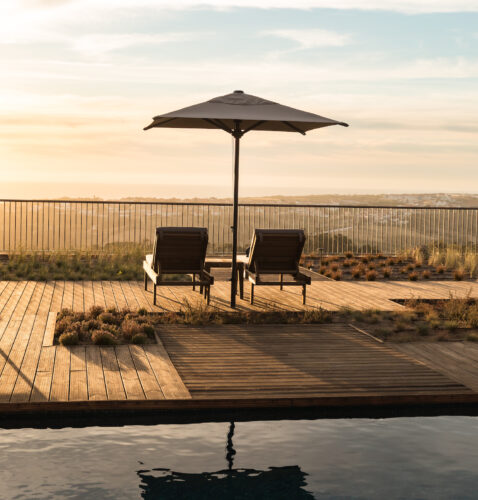
It is obvious that with so much attention to detail, nothing is left to chance in terms of gastronomy. Every morning, the chef of the Emme restaurant goes to the fish market to select the local catch of the day on the spot for his guests. Strict attention is also paid to the regional origin of all other ingredients; a large part of the prepared vegetables comes from the in-house garden. The wine list is less rigorous, so that one or the other French vine can be spied, but the focus here is also clearly on Portugal. A special highlight to celebrate all the epicurean regionality not only on the plate, but to be especially close to the landscape that gave you all these ingredients while dining, will offer Emme on Fire starting this year. Here you then sit in nature, at a long table next to a campfire. Fire is then also the main element of preparation in this gastronomic outdoor dependence.
COMMUNITY SPIRIT AS A BUSINESS MODEL
In the heart of Umbria, about halfway between Florence and Rome, lies the small boutique hotel Vocabolo Moscatelli with which Catharina Lütjens and Frederik Kubierschky have fulfilled a lifelong dream. Previously, the two gained hotel industry expertise in various luxury hotels in Zurich, but at some point the desire arose to, as Kubierschky says, »set the rules of the game« themselves. The twelfth-century Umbrian monastery, lying dormant, provided the perfect playing field. There is this tension between form and content, the form was already definitely given in our project by the beautiful monastery, it was important for us to use this plus point and then also pack in quite a lot of content.« He continues by noting: »Especially because we are here in a small, rural local community, it was important to us not to appear as foreign investors who just put a foreign body in the pampas.« Rather, he says, from the beginning they were concerned with resurrecting what existed, which had perhaps fallen into a bit of oblivion. This approach became the guiding principle for the entire renovation and is now omnipresent in day-to-day operations.
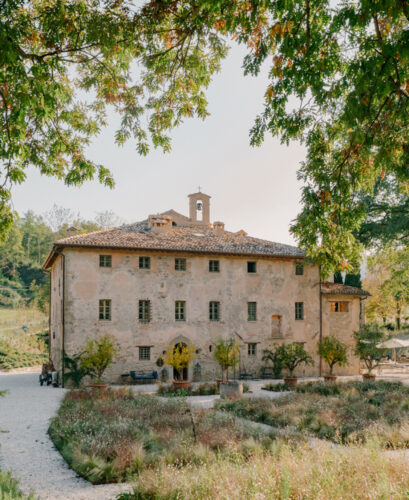
»In the construction phase, which fell fully into the Corona pandemic, it helped us extremely in many respects that we worked almost exclusively with craftsmen and manufactures from Tuscany and Umbria, i.e. from the immediate surroundings, since closed borders and the material supply crisis passed us by in a big way«, explain the hoteliers. The schedule was quite tight, the monastery was purchased in November 2019, then had a year and a half for planning and the same period for the historical reconstruction.
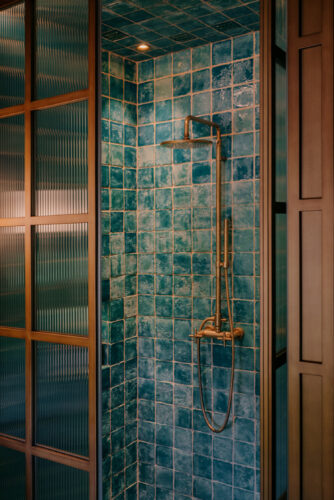
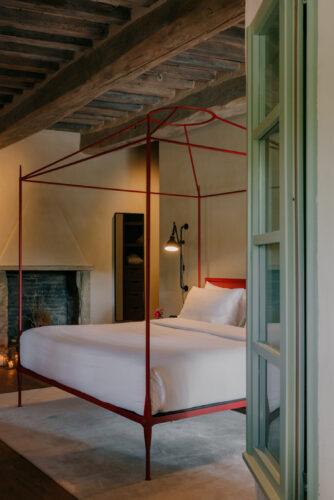
Lütjens and Kubierschky emphasize that an important aspect of the overall design from the very beginning was also the idea of becoming a meeting place for the local population. »The idea of community and, above all, the desire to become part of the local community was essential for us«, they say. However, it was clear that this should not be done by pure ingratiation or adaptation. »Especially with the gastronomic concept, it was important to us to also go a bit different ways than those known locally so far. We are in Umbria in the meat chamber of Italy. There is nothing wrong with that in and of itself. But since there are already very good, often very simple restaurants that focus on meat, our idea was to create a place that complements what already exists. The idea of sustainability also plays a role for us.« The result is a menu that is not purely vegetarian, but does offer significantly more meat-free alternatives than is usual in Umbria.

The clear commitment to regionality is definitely a core element in terms of gastronomy but also in the overall concept, but it is not pursued dogmatically. »Umbria is a region of artists and craftsmen. This means that in terms of design and furnishings, we were really able to draw on the full range without going far afield,« says Catharina Lütjens, and you can clearly detect the enthusiasm in her voice. »For the artwork in the rooms, we worked with a curator who is originally from Umbria, and who developed a concept for us in which, although there are local artists, there are also one or two international painters. However, we are particularly proud and happy that we have also discovered artists who come from the immediate neighborhood and whose works are now integrated into our hotel.« Guests seem to sense the coherence of the location, because »for no other works of art do we receive so many compliments and so much encouragement.« The cooperation with the local community offers a great opportunity for the Vocabolo, explains Kubierschky: »Our main goal was always to create a place where you can meet interesting people. The fact that we already involved exciting craftsmen and artists from the area in the development phase led to them making the hotel one of their epicenters after the opening, bringing friends with them and recommending us to others. So this approach has also been extremely helpful in gaining acceptance from the local community.«
MUNICH ECLECTICISM
However, the renowned luxury hotel Bayerischer Hof in Munich proves that the curated guest experience is not just something that small boutique hotels want to and can offer. With almost 350 rooms and a history rich in tradition, the hotel is a true grand hotel in every sense of the word. However, this does not mean that the institution does not focus on individuality in design. On the contrary, the size of the hotel, both in terms of public areas but also in terms of number of rooms, is used to make the most of it. If boutique hotels were the small, highly specialized niche galleries in the art world, then the Bayerischer Hof, as a counterpart, is the large, epoch-spanning museum that can afford to focus on the various styles without having to cut back on attention to detail, quality and selection. Although this strategy can be used to address various target groups, Philipp Herdeg, the hotel’s PR director, also notes in conversation that renewal and style expansion are always risky undertakings that can irritate or even scare away regular guests. The Bayerische Hof has floral-opulent Laura Ashley rooms as well as noble-traditional suites and rooms in the style of Count Pilati, and in addition, truly contrasting, various rooms designed by Axel Vervoordt. While the Laura Ashley-loving guest may not care whether someone next door is enjoying Vervoordt’s wabi-sabi aesthetic behind a closed door, this was a real political issue when the Belgian redesigned the Garden Restaurant. Of course, the radical-looking redesign also meant that a certain clientele could not be retained, says Herdeg.
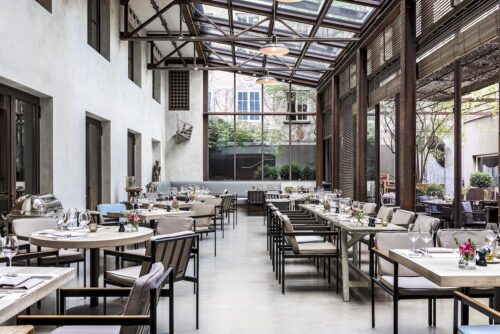
»In the overall context, however, it is important to consider not only Vervoordt’s simple aesthetics but also his approach to creating. As modern and purist as Axel Vervoordt’s designs may seem, his love of the history of materials, the need to create something new from historical elements, is something that is in absolute harmony with the values of Bayerischer Hof .« Overall, the new, purist elements have also been extremely well received. »We actually also have regular guests who enjoy precisely this heterogeneity of our rooms and switch between the different styles during their various stays.« It is also important for Herdeg to emphasize that the different room types at Bayerischer Hof are not categorized differently based on their style. This is done solely on the basis of size. So 50 square meters of Laura Ashley is not superior or inferior to another style, and thus also on a par with 50 square meters of Vervoordt in terms of price. Accordingly, there are also unifying elements that are identical in all rooms, such as towels, hangers and cosmetic products. In order to match a wide range of styles, more neutral elements were chosen here to blend in easily.
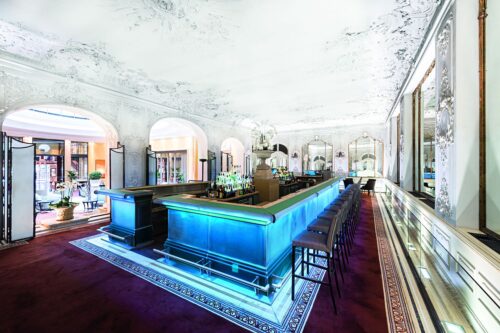
Perhaps the Bayerische Hof not the perfect place for radical representatives of a single style, but to dine in the Wabi-Sabi ambience during a short stay in Munich, to drink another digestif in the Bavarian-baroque Spiegelsaal afterwards and finally to spend the night in the cozy Laura Ashley four-poster bed, all this without going outside the front door, is certainly not a bad selling point to a very large, demanding and yet heterogeneous target group.

